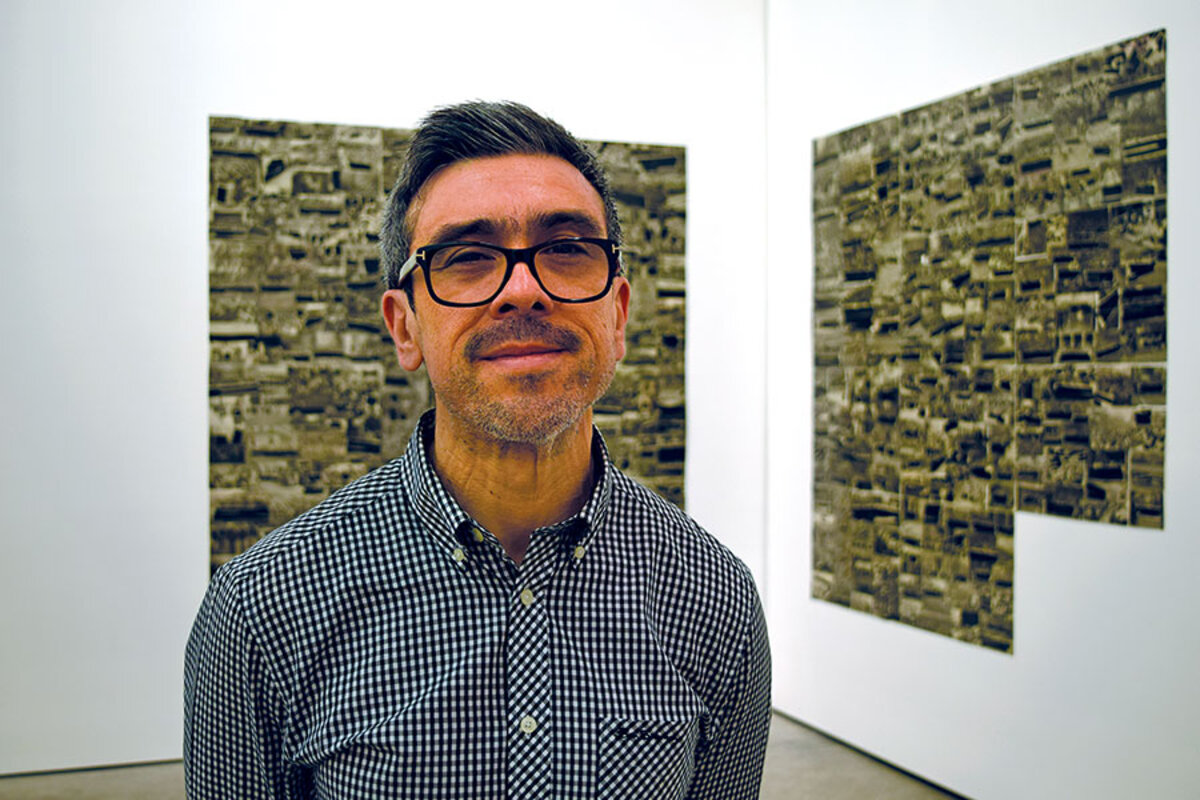Violence plunged after he brought the arts to a Tijuana neighborhood
Loading...
| Tijuana, Mexico
At the top of a hill in Camino Verde, a neighborhood long known for its gang turf wars and struggling families, sits a drab concrete-slab building.
It’s a substantive structure, which stands out in this community of informally built homes in Tijuana, Mexico. And that’s the whole idea.
“We built a bunker, and it changed everything,” says Raúl Cárdenas Osuna, an architect and artist who uses his hands – and cellphone photos – as he animatedly describes his work.
Mr. Cárdenas is the founder and director of Torolab, an art and urban planning collective founded in Tijuana in 1995. He’s dedicated his life to creating social change through community-driven art initiatives, and his unique outlook played an important role in transforming Camino Verde from a grim environment into a neighborhood of hope and promise.
The “bunker” houses the Torolab project known as La Granja Transfronteriza, or La Granja (The Farm) for short – a place brimming with the arts and more that draws community members of all ages.
Between 2007 and 2010, at the height of drug cartel violence, citizens fled abroad or holed up indoors, businesses shuttered, and tourism, crucial to the economy, plummeted to historic lows. As Tijuana garnered a reputation as one of the most violent places in the world, Camino Verde held the inglorious title of the most dangerous neighborhood in the city.
But today, Camino Verde’s story is changing. And La Granja, founded in 2010, has been no small factor.
On weekday afternoons, the bunker is bustling with young kids screeching out notes on their violins under the guidance of instructors, some from the Orchestra of Baja California. Families gather on the weekend to grow vegetables in the nascent community garden. A basic kitchen techniques course is taught by Tijuana’s renowned Culinary Art School. There’s a computer lab upstairs, and parents can pursue their GED certificates after work.
Most strikingly, however, violence in Camino Verde has plunged, falling by 85 percent since 2010, according to Torolab staff, citing state statistics.
“Just saying that [number] I get a lump in my throat. It gives me chills. This was one of the most violent places in the world, where you weren’t expected to make it out,” Cárdenas says. “Now it’s common to see governments and arts schools from around the globe coming to the neighborhood to learn.”
Cárdenas grew up in the Mexican coastal city of Mazatlán. Architecture was something he was exposed to early on through his father’s career, and he moved to the border city of Tijuana to study it in college. The do-it-yourself nature of the city became an inspiration for him.
But he discovered that despite the beauty of architecture and its potential to transform lives, projects involving it were financially out of reach for most people.
“I realized architecture was a beautiful form of art that doesn’t matter,” he says. Yet he saw that “the art world needed a little more architecture and architecture needed a little more of the art world” – and together, these fields could have a meaningful effect on communities in need.
Taking on Tijuana's violence
When, in 2010, a group of local leaders came together to talk about what they could do to change Tijuana’s violent trajectory, Cárdenas took charge of pinpointing where they could make the biggest difference.
“What people want and what people need is to have a livable space,” he says.
Cárdenas started studying the city. He mapped 911 calls, incidences of violence, imprisonment rates, and nutritional poverty. He found these issues were largely concentrated in one community: Camino Verde.
Cárdenas sought input from the neighborhood’s residents on what it needed most. Alma Teresa Carillo was suspicious of him during their first encounter because in the decades she had lived in Camino Verde, it was only people jockeying for votes who knocked on her door.
Still, Ms. Carillo joined a writing class organized by Torolab, where participants shared family recipes and the stories that went with them. “I was unemployed and figured I might as well take advantage of what they were offering while they were here,” Carillo says.
“Then I started to realize something,” she says. “They’re asking what we need. They aren’t telling us what we need. Something was happening.”
Today, Carillo is one of La Granja’s biggest advocates, calling on neighbors to get involved. “Their work has changed my life. And it’s changing the community,” she says.
Through Cárdenas’s door-to-door surveys and courses like the cookbook project, he learned about other challenges, such as Camino Verde’s canal. The city built the canal after heavy rains in 1993 resulted in landslides and dozens of deaths, and it cut through the center of the neighborhood, coming to serve as a dividing line for rival gangs.
The group of Tijuana leaders petitioned for government funding, building a soccer pitch and a skate park that covered the canal and did away with the gangs’ boundary. The leaders were also able to set up a boys and girls club and community center. And the very last project to get funding was La Granja’s bunker.
Part of the reason it took a while to get funding is because La Granja is hard to describe. “People would say, ‘Oh, a community center? But we already have one of those,’ ” Cárdenas recalls. To him, it’s much more than that; it’s a “knowledge farm.” Residents are not only learning new skills through organized opportunities, but they’re also contributing their own talents for the improvement of the neighborhood.
Film adaptation of Shakespeare
One way La Granja can be seen as a “knowledge farm” is through its artist and scientist residencies. The first group of artists to complete a residency – in February 2014 – was a trio from Austria that wanted to make a film adaptation of Shakespeare’s “Titus Andronicus.”
The play is tough and violent, and the team says it was a little surprised at first by the interest in community participation.
“We had a stable group of 20 to 30 people,” says Manfred Rainer, one of the artists in residence. Men and women of all ages workshopped the script, decided where and how to shoot, and acted in the film.
The final product won an award for Best Documentary and Hybrid at the Austrian American Short Film Festival in New York this year.
Cárdenas was key in getting folks interested, says Hannah Oellinger, another member of the trio. “He is just a person that if he says to a crowd of people, ‘Hey, don’t you want to shoot a movie?,’ suddenly a lot of people want to shoot a movie.”
For many in the community, the overlap between the story line of “Titus Andronicus” and the day-to-day realities in Camino Verde made the process deeply personal. “For some of us, [the script] was an easier way to confront and talk about what we see here daily,” Carillo says.
The artists saw La Granja’s value. “It functions as an example of something positive going on. It shows concretely that possibilities exist: You can improve your situation, even in the worst district of Tijuana,” says Stefan Wirnsperger, the third member of the trio.
La Granja currently runs off government and private grants, as well as artwork sales by Torolab. But Cárdenas hopes that by early next year, it will be self-sustaining.
Already, the project has received multiple prizes and global recognition, including being selected as the best arts-intervention project with a social impact by Harvard University’s Cultural Agents Initiative, which found it could be replicated in other neighborhoods across the world.
“If this works in Camino Verde,” Cárdenas says, “I know we can empower other places, too.”
• Whitney Eulich’s reporting in Tijuana was supported by the International Women’s Media Foundation.
How to take action
helps people give to and volunteer for top-performing charitable organizations around the world. All the projects are vetted by Universal Giving; 100 percent of each donation goes directly to the listed cause. Below are links to three groups that provide food to children or work with those in agriculture:
gives food, clothing, education, and medical aid to more than 200 orphans and other children in rural Kenya. Take action: .
supplies food and educational opportunities to impoverished children in Port-au-Prince, Haiti. Take action: .
creates opportunities for poor, entrepreneurial farmers in sub-Saharan Africa to make money. Take action: .





